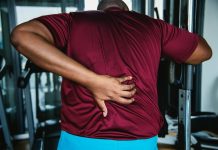
Chronic alcohol drinking may increase the sensitivity to pain, as suggested by a study from scientists at Scripps Research.
The research also indicates potential new drug targets for treating alcohol-associated chronic pain and hypersensitivity.
Alcohol use disorder (AUD), which includes alcohol abuse, dependence, and addiction, affects 29.5 million people in the United States.
Over time, AUD can trigger the development of numerous chronic diseases, including heart disease, stroke, liver disease, and some cancers.
Among the many impacts of long-term alcohol consumption is pain.
More than half of people with AUD experience persistent pain of some type, including alcoholic neuropathy, which is nerve damage that causes chronic pain and other symptoms.
Studies have also found that AUD is linked to changes in how the brain processes pain signals and how immune system activation occurs.
Moreover, during withdrawal, people with AUD can experience allodynia, where a harmless stimulus is perceived as painful.
Therefore, understanding the underlying causes of these different types of alcohol-related pain is crucial.
In the new study, researchers compared three groups of adult mice: animals that were dependent on alcohol (excessive drinkers), animals that had limited access to alcohol and were not considered dependent (moderate drinkers), and those that had never been given alcohol.
The study revealed that in dependent mice, allodynia developed during alcohol withdrawal, and subsequent alcohol access significantly decreased pain sensitivity.
In comparison, about half of the mice that were not dependent on alcohol also showed signs of increased pain sensitivity during alcohol withdrawal.
However, this neuropathy was not reversed by re-exposure to alcohol, unlike the dependent mice.
Furthermore, the researchers found that while inflammation pathways were elevated in both dependent and non-dependent animals, specific molecules were only increased in dependent mice.
According to the study, these findings suggest that chronic alcohol consumption may make people more sensitive to pain through two different molecular mechanisms.
One mechanism is driven by alcohol intake, and the other is driven by alcohol withdrawal.
Understanding the molecular mechanisms behind these two types of pain could lead to the development of different ways to treat each type.
Additionally, it could unveil new potential molecular targets that can be used to distinguish these types of pain and potentially be used in the future for the development of therapies.
How to prevent chronic pain
Preventing chronic pain depends on the underlying cause of the pain, but here are some general tips that may help:
Stay Active: Regular exercise can help prevent and reduce chronic pain. Exercise helps to strengthen the muscles, improve flexibility and reduce stiffness. It also releases endorphins, which are the body’s natural painkillers.
Maintain a healthy weight: Being overweight puts extra strain on the joints and can lead to chronic pain, especially in the knees and hips.
By maintaining a healthy weight, you can reduce the risk of developing chronic pain.
Practice good posture: Maintaining good posture while sitting, standing and walking can reduce the stress on the spine and joints, preventing chronic pain.
Quit smoking: Smoking can lead to chronic pain by reducing blood flow to the tissues and increasing inflammation. Quitting smoking can help to prevent chronic pain and improve overall health.
Manage stress: Chronic stress can cause muscle tension, leading to chronic pain. Learning stress-management techniques such as meditation, yoga, or deep breathing can help reduce the risk of developing chronic pain.
Eat a healthy diet: A balanced diet with plenty of fruits, vegetables, whole grains, lean proteins and healthy fats can help reduce inflammation in the body, which can lead to chronic pain.
Avoid injury: Take steps to prevent injury, such as using proper lifting techniques, wearing protective gear during sports, and taking regular breaks when working at a desk.
If you have chronic pain, it’s important to consult with a healthcare provider to determine the underlying cause and develop a personalized treatment plan.
If you care about pain, please read studies that 1 in 3 people with chronic pain turn to marijuana, and powerlifting is an effective exercise for chronic low back pain.
For more information about wellness, please see recent studies that Krill oil could improve muscle health in older people, and eating yogurt linked to lower frailty in older people.
The study was conducted by Vittoria Borgonetti et al and published in the British Journal of Pharmacology.
Copyright © 2023 Knowridge Science Report. All rights reserved.



